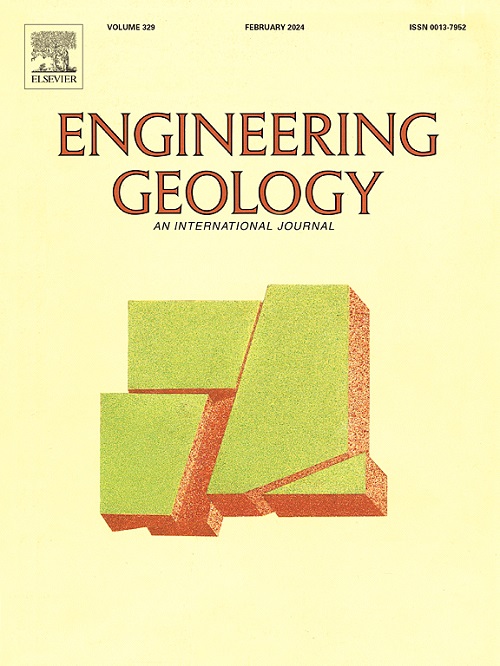Influence of bedding on fracture toughness and failure patterns of anisotropic shale
IF 6.9
1区 工程技术
Q1 ENGINEERING, GEOLOGICAL
引用次数: 0
Abstract
The initiation and propagation of hydraulic fractures are closely related to the fracture ability of rocks. Such processes in shale reservoirs are, to a certain extent, controlled by bedding. However, the control mechanism of bedding on the anisotropy of fracture toughness and fracturing behavior remains unclear. In this study, a series of numerical notched semi-circular bend (NSCB) tests are conducted using the discrete element method (DEM) to investigate the influence of bedding properties on the anisotropy of fracture toughness and fracture patterns. Based on the DEM framework, a novel simulation method is proposed to accurately identify two key fracture indicators, the fracture process zone (FPZ) and crack tip opening displacement (CTOD), to reveal the fracture driving mechanism. The results show that the fracture toughness of shale is negatively correlated with bedding angles β but positively correlated with bedding spacing and bedding strength. Both the bedding strength and spacing significantly influence the fracture pattern of the specimens with β = 0°–60°, whereas the specimen with β = 90° is scarcely affected by the bedding planes. The evolution of the CTOD and FPZ in shale exhibits distinct phased characteristics. Due to the strong suppression effect of low-angle bedding planes on pre-peak crack deflection, the CTOD and FPZ exhibit opposite trends with respect to bedding angles before and after the peak load. This study facilitates the understanding of the fracture propagation process of anisotropic shale and could provide guidance for hydraulic fracturing design in shale reservoirs.
垫层对各向异性页岩断裂韧性和破坏模式的影响
水力裂缝的形成和扩展与岩石的断裂能力密切相关。页岩储层中的此类过程在一定程度上受层理控制。然而,垫层对裂缝韧性和压裂行为各向异性的控制机制仍不清楚。本研究采用离散元法(DEM)进行了一系列缺口半圆弯管(NSCB)数值试验,研究了垫层性质对压裂韧性和压裂模式各向异性的影响。在 DEM 框架的基础上,提出了一种新的模拟方法,以准确识别断裂过程区(FPZ)和裂纹尖端张开位移(CTOD)这两个关键断裂指标,从而揭示断裂驱动机制。结果表明,页岩的断裂韧性与铺层角度β呈负相关,但与铺层间距和铺层强度呈正相关。垫层强度和垫层间距都对 β = 0°-60° 试样的断裂模式有显著影响,而 β = 90° 试样几乎不受垫层平面的影响。页岩中 CTOD 和 FPZ 的演变具有明显的阶段性特征。由于低角度碾压面对峰值前裂纹挠度有很强的抑制作用,峰值载荷前后 CTOD 和 FPZ 与碾压角的变化趋势相反。这项研究有助于理解各向异性页岩的裂缝扩展过程,并为页岩储层的水力压裂设计提供指导。
本文章由计算机程序翻译,如有差异,请以英文原文为准。
求助全文
约1分钟内获得全文
求助全文
来源期刊

Engineering Geology
地学-地球科学综合
CiteScore
13.70
自引率
12.20%
发文量
327
审稿时长
5.6 months
期刊介绍:
Engineering Geology, an international interdisciplinary journal, serves as a bridge between earth sciences and engineering, focusing on geological and geotechnical engineering. It welcomes studies with relevance to engineering, environmental concerns, and safety, catering to engineering geologists with backgrounds in geology or civil/mining engineering. Topics include applied geomorphology, structural geology, geophysics, geochemistry, environmental geology, hydrogeology, land use planning, natural hazards, remote sensing, soil and rock mechanics, and applied geotechnical engineering. The journal provides a platform for research at the intersection of geology and engineering disciplines.
 求助内容:
求助内容: 应助结果提醒方式:
应助结果提醒方式:


